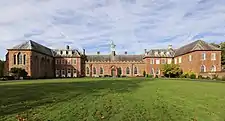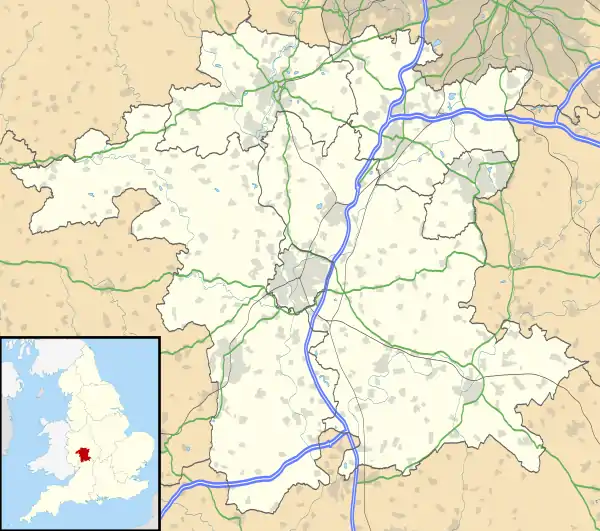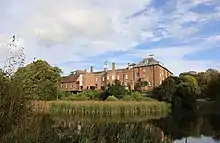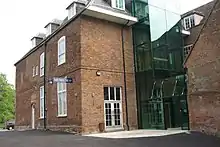Hartlebury Castle
Hartlebury Castle, a Grade I listed building,[1] near Hartlebury in Worcestershire, central England, was built in the mid-13th century as a fortified manor house, on manorial land earlier given to the Bishop of Worcester by King Burgred of Mercia.[2][3] It lies near Stourport-on-Severn in an area with several large manor and country houses, including Witley Court, Astley Hall, Pool House, Areley Hall, Hartlebury and Abberley Hall (with its clock tower). The castle became the bishop's principal residence in later periods.[4]
| Hartlebury Castle | |
|---|---|
| Worcestershire, England | |
 The exterior of Hartlebury Castle from the front | |
 Hartlebury Castle | |
| Coordinates | 52.3386°N 2.2421°W |
| Grid reference | grid reference SO836712 |
| Site information | |
| Open to the public | Yes |
History
From the early 13th century until 2007, Hartlebury Castle was the residence of the Bishop of Worcester.
Bishop Walter de Cantilupe, a supporter of Simon de Montfort, began to fortify the Castle, which was embattled and finished by his successor, Godfrey Giffard, 1268. The gatehouse was added in the reign of Henry VI by Bishop Carpenter.[5]
In 1646 during the Civil War Hartlebury Castle was strongly fortified and held for King Charles I by Captain Sandys and Lord Windsor, with 120 foot soldiers and 20 horse (cavalry troopers), and had provisions for twelve months. When summoned by Colonel Thomas Morgan for Parliament, it surrendered in two days without firing a shot.[5] The Castle was slighted,[3] and the Parliamentary Commissioners seized the Castle and manor, and sold them to Thomas Westrowe for £3,133 6s. 8d. At the Restoration they were given back to the Bishop of Worcester.[5]
The avenue of limes in the park was planted by Bishop Stillingfleet. Bishop Pepys made a present of the deer, which had been kept there from time immemorial, to Queen Victoria.[5] Some idea of how a bishop's family lived in the mid-19th century can be gained from the diary of the ten-year-old Emily Pepys, daughter of Bishop Pepys, which covers a six-month period in 1844–5.[6]
The Hurd Library was built by Bishop Hurd in 1782. It still contains his extensive and unique collection of books including works from the libraries of Alexander Pope and William Warburton. The copy of the Iliad from which Pope's translation was made is among them.
By 1890 some of the Castle moats had been filled up and laid out as flower gardens.[5]
With the coming of Bishop Inge in 2008, the Bishop's residence was moved from the Castle to a house adjacent to the Cathedral in the city of Worcester itself. In 1964, the north wing of the castle was taken over by Worcestershire County Council for the creation of a County Museum and in 1966 the Worcestershire County Museum was opened to the public.
In 2010, BBC Midlands News reported that Hartlebury Castle was being put up for sale and that local people had started a campaign to stop it falling into private hands.
Hartlebury Castle Preservation Trust (HCPT), a registered charity,[7] was formed to preserve Hartlebury Castle for education, the use and enjoyment of everyone, and to allow the Hurd Library to remain intact and located within the Castle.
Campaigners were given until April 2011 to raise £2 million or the house would be put on the open market. It was reported on 17 August 2012 that HCPT had agreed to pay its owners, the Church of England, £2.45 million for the freehold of the buildings, gardens and parks. Moves to raise the purchase price from the Heritage Lottery Fund and from private donors were in progress.[8]

In April 2013 HCPT was successful in its round one Heritage Lottery funding application. This provided funds to develop a Business Plan for the future of Hartlebury Castle.
In October 2014 HCPT, with partners Worcestershire County Council and Museums Worcestershire, was awarded £5M by the Heritage Lottery Fund to preserve Hartlebury Castle, its estate and assets, including the Hurd Library.
In March 2015 HCPT purchased Hartlebury Castle with its surrounding 43-acre estate. The Trust will transform the historic palace into a unique visitor attraction, with the state rooms and County Museum accessible to everyone.
In May 2016 a virtual reality tour of the Hurd Library was created.[9]
Worcestershire County Museum

The Worcestershire County Museum is housed in the servants' quarters of Hartlebury Castle. The exhibits focus on local history, and include toys, archaeology, costumes, crafts by the Bromsgrove Guild, local industry and transportation, and area geology and natural history. There are period room displays including a schoolroom, nursery and scullery, and Victorian, Georgian and Civil War rooms.
The castle grounds include a cider mill and the Transport Gallery that features vehicles including a fire engine, hansom cab, bicycles, carts and a collection of Gypsy caravans.
Notes
- "Hartlebury Castle, Hartlebury". British Listed Buildings. Retrieved 16 September 2011. (The listing text provides a full architectural description).
- Hooke 1990, p. 101.
- Worcestershire Council staff 2010.
- Willis-Bund 1913, pp. 380-387.
- Burton 1890, p. 201.
- Avery 1984, "Introduction".
- Charity Commission. HARTLEBURY CASTLE PRESERVATION TRUST, registered charity no. 1127871.
- BBC News, 17 August 2012. Retrieved 25 August 2012.
- Hurd Library VR Tour
References
- Avery, Gillian (1984). "Introduction". The Journal of Emily Pepys. London: Prospect Books. ISBN 0-907325-24-6.
- Willis-Bund, John William (1913). "Parishes: Hartlebury". The Victoria History of the County of Worcester. 3. pp. 380–387.
- Hooke, D. (1990). Worcestershire Anglo-Saxon Charter-bounds. Woodbridge: Boydell. p. 101.
- Worcestershire Council staff (23 February 2010). "A Brief History of Hartlebury Castle". Worcestershire County Council. Archived from the original on 23 November 2010. Retrieved 1 November 2011.
- Attribution
- Burton, John Richard (1890). A history of Kidderminster, with short accounts of some neighbouring parishes. London: E. Stock. p. 201.
External links
- Worcestershire County Museum - official website
- The Hartlebury Castle Preservation Trust